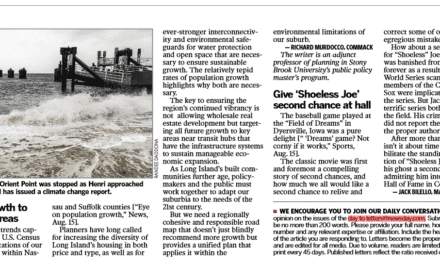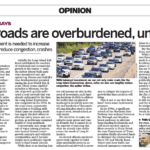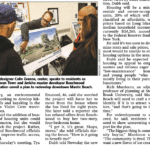The following was written for LIBN:
Recently, I wrote a piece on Suffolk County Executive Steve Bellone’s Connect Long Island proposal, which would deploy buses on critical north/south corridors and employment hubs. The project, if implemented, would be a regional win, but I had said that the sales pitch was off.
Bellone was trying to make the connection between his transportation proposal and our hurricane preparedness. I wrote “The proposed system is a valid concept on its own; it’s the association Bellone is making with these other issues that weakens Connect Long Island’s sales pitch.”
Much to my dismay, the Long Island Rail Road is currently making the same mistake with its double track project – an effort to add a second set of tracks to the 18-mile stretch between Ronkonkoma and Farmingdale. LIRR officials are saying the project is critical for future storm resiliency; out of the railroad’s $409-million dollar disaster mitigation proposal, $300 million would go toward double track.
But here’s the thing: Double track is critical for the region. The project will help prevent the delays that currently reverberate throughout the system and will eliminate a large bottleneck in the transit network. Beyond that, double track will allow for increased peak services. There is a saying in planning: A city that can move easily is a city that grows easily. Long Island is no exception from this rule.
So then it should be asked, why cheapen the project’s merits by weakly tying in storm mitigation and Sandy recovery? Clearly, the double track effort is of regional significance. Is the linkage with Sandy recovery/storm mitigation the only viable way to secure $300 million needed to finish the project?
A Larger Issue
On Long Island, our failure to get big projects moving has created the need to shoehorn any issue (be it Sandy, Irene, earthquakes, locusts, etc.) into the project’s proposal for funding in order to make it more palatable to funders (be it government or private) and the public. The policymakers’ thought process seems to be as follows:
Location: A public meeting on Long Island
Policymaker 1: Well, we need to build this extra lane on Arielle Highway! Traffic is awful! It’s…preposterous!
Public: Extra lanes will add more traffic, noise, barium in the skies…allow those people to move in…NIMBY!
Policymaker 1: Sandy! Yeah, that’s it! Why, if we don’t build a new lane a new Hurricane Sandy will come and destroy everything! Remember Sandy? Well, if we build this lane, it will help us, uh, evacuate.
Public: Well, in that case, build 10 more lanes!
In the above hypothetical example, the Arielle Highway is probably in desperate need of a new lane. From a planning perspective, the addition of a lane would alleviate traffic, and remove some of the burden off the surrounding highways. Often, these rational arguments aren’t enough for the public, so policymakers are forced to go to the extremes to help make the case.
While the LIRR can be faulted for shoehorning in a link between storm mitigation and double track, the residents of Nassau and Suffolk have made it necessary to do so.
It’s a sick cycle:
1. A project gets proposed.
2. NIMBYs decry it.
3. Proposers make an unrelated link to big event (Sandy, Irene, etc.) in attempt to get funding or permits.
4. Media and public collectively and cynically say, “Really?”
5. Rinse, repeat ad nauseum.
Often, minds are so closed to new regional ideas and so devout to the status quo that these wild ties to regional focusing events are part of the process. The problem is arbitrarily presenting the Hurricane Sandy connection as one of the main arguments as to why Long Island needs double track cheapens the argument of our actual storm hardening needs (i.e. buried lines, natural wetland restoration). The public has limited faith in government as it is. Every time policymakers try to sell a bill of goods, the public becomes more jaded and the process as a whole suffers. Remember: The best plans are open, backed by data and publicly vetted.
A Solution?
The best solution? Honesty. Christopher Jones of the Regional Plan Association said it best to Newsday: “The mitigation aspects of it are not as obvious as they are for projects like drainage but they’re still real.”
Be honest with the public. State why double track needs these funds, how significant the project will be when it’s completed and say, “Oh, by the way, not only will double track increase the LIRR’s level of service, it may also help with future storm evacuations.” Don’t oversell. As I wrote about Bellone’s effort, the project is right for the region, but the sales pitch is off.
Richard Murdocco is a digital marketing analyst for Teachers Federal Credit Union, although the views expressed in this post are Murdocco’s alone and not shared by TFCU. Follow him on Twitter @TheFoggiestIdea, or email him at rich.murdocco@gmail.com.











